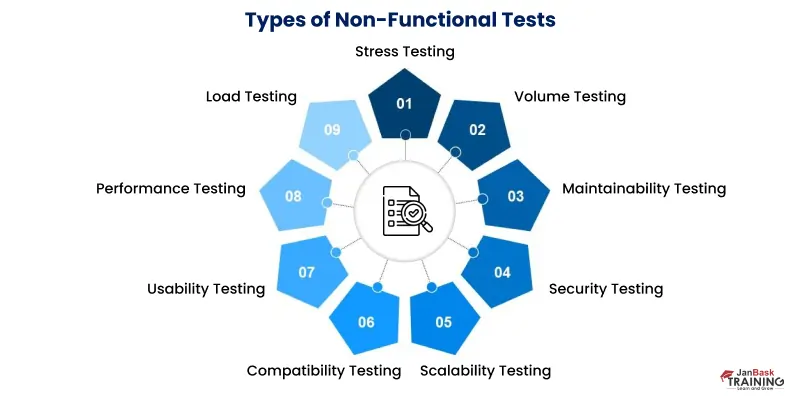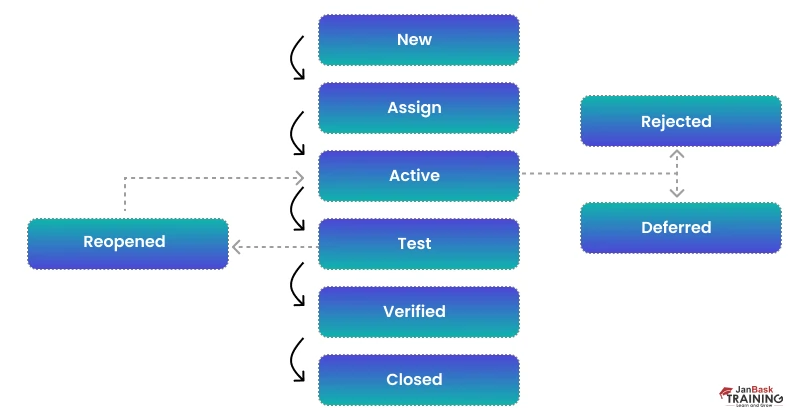 Grab Deal : Upto 30% off on live classes + 2 free self-paced courses - SCHEDULE CALL
Grab Deal : Upto 30% off on live classes + 2 free self-paced courses - SCHEDULE CALL

 Grab Deal : Upto 30% off on live classes + 2 free self-paced courses - SCHEDULE CALL
Grab Deal : Upto 30% off on live classes + 2 free self-paced courses - SCHEDULE CALL

The world of QA (Quality Assurance) is booming! As software development thrives, the demand for skilled QA professionals to ensure quality and functionality is higher than ever. Landing your dream QA job can be exciting, but the interview process can feel daunting. This comprehensive guide equips you with the knowledge and confidence to ace your interview!
We've compiled a strategic breakdown of frequently asked QA interview questions and answers, meticulously categorized by experience level:
By familiarizing yourself with these questions and crafting well-structured responses, you'll be well on your way to impressing your interviewer and securing that coveted QA position. Let's dive in and unlock your QA interviewing potential!
Ans:- While all three terms are related to ensuring quality, they have distinct roles:
Quality Assurance (QA): This is the big-picture approach. QA focuses on preventing defects by establishing quality standards throughout the entire project lifecycle. It involves defining what "quality" means for the project, setting up processes to achieve that quality, and continuously monitoring those processes for improvement.
Quality Control (QC): This is the hands-on inspection part. QC focuses on identifying defects in the final product or service. It involves activities like testing, code reviews, and inspections to ensure the product meets the established quality standards.
Testing: This is a specific activity within QC. Testing involves executing the product or service under various conditions to find bugs or errors. It's a crucial part of identifying defects, but it's not the only QC activity.
Ans:- Ideally, QA activities should begin from the very beginning of a project. This allows for:
Ans:- The STLC is a phased approach to software testing that ensures a thorough and efficient testing process. There are various STLC models, but they typically involve phases like:
Ans:-
Ans:- A good test case should include:
Ans:- A good test case is one that:
A bad test case might be:
Ans:- Here are some strategies for running a large set of test cases efficiently:
Ans:- QA testers can play a valuable role in addressing production issues by:
Ans:- To prevent this bug from reappearing in the future, the most effective strategy is to create a dedicated test case targeting the specific issue. This test case should then be integrated into the regression suite. The regression suite ensures that previously fixed bugs are not reintroduced with new code changes. Additionally, considering alternative test scenarios that cover similar functionalities can further strengthen the testing process.
Ans:- Functional Testing:
Non-Functional Testing:
Ans:- Here is how to answer such kinds of QA tester interview questions. Negative testing will check whether the system behaves gracefully even when non-valid inputs are given. At the same time, positive testing will check whether the system behaves as per the expectations or not for the valid inputs.
Ans:- There are two popular techniques requiring traceability and the coverage matrices to check either testing is complete for a projector still need to perform.
Ans:- There are plenty of technical requirements to consider when writing a test case like functional specifications, user requirements, wireframes, user stories, acceptance criteria, or UAT test cases, etc. Make sure not to miss these kinds of major QA test interview questions while preparing when looking for a QA Career Path.
Ans:- Handling interview questions QA can be accomplished by answering them as: Yes, this is possible to write a test case even in the absence of concrete documents. In this case, you have to be more conscious and collaborate with BA team continuously. Also, sit with the developers and try to understand the project requirements deeply. Based on the discussion, you can define the test conditions yourself and design the test case without any concrete documents.
Ans:- Verification is the process of checking the progress of a project to make sure that you are on the right track or not. Validation is the process of evaluating the final output of the project to make sure that it perfectly meets the client's needs and requirements.
Ans:- Verification techniques are static in nature. A few verification techniques that I have used for my past projects are – the walkthrough verification technique, Review, and Inspection.
Ans:- Load testing will check the system performance under heavy loads. On the other hand, stress testing will test the system behavior when test cases are executed under stress. To expand your knowledge further in manual testing, check out these Top 110+ Manual Testing Interview Questions & Answers.
Ans:- Here is how to answer such kinds of QA tester interview questions.
Yes, of course. The answer to this question is exclusive to the individual and depends on the experience of a candidate.
Ans:- For this purpose, you should check the technical specifications for a test case. If you still have any doubts, then ask your senior team members.
Ans:- You first need to calculate the cyclomatic complexity of a software product to check how much testing is required by a particular software.
Ans:- Testware is defined as artifacts for testing like test cases, test plans, test data needed to execute or design a test.
Ans:- The build is a product given to the testing team by the development team for inspecting the quality issues while Release is the final installable product handed over to customers by the tester or developer. Make sure not to miss these kinds of major QA test interview questions while preparing for the QA interview.
Ans:-
Ranorex is a powerful test automation tool you need to learn, have a look at this Ranorex Tutorial Guide and expand your knowledge base.
Ans:- Bug release is a technique when the software application is handed over to the testing team knowing that a bug is present in the build and it can be removed before the final handover. Bug leakage is something when a bug is discovered by end-users and not detected by a testing team or developers.
Ans:- Data-driven testing is an automation testing framework which tests different input on the AUT (Application Under Test). These values are directly taken from the data files in different formats like CSV files, excel files, and more.
Ans:-
Ans:-
This is among the top 36 situational interview questions and answers that you cannot miss while preparing for your interview questions QA interview.

Ans:- Different Types of Testing
Ans:- The testing for all branches of code is known as the branch testing.
Ans:- When testing is focused on limit conditions, it is termed as the boundary condition.
Know how much does a QA tester can make, explore the QA tester's Salary guide.
Ans:- Here is the answer to one of the frequently-asked interview questions QA :
Ans:- A thread testing is a top-down testing approach where the progressive integration of components is followed as opposed to the integration of components by successively lower levels.
Ans:- It is a process for controlling and documenting changes made during the life cycle of a project. Change control and release control are important aspects of configuration management.
Ans:- This is the testing phase, where a tester tries to break the system by trying the system’s functionality randomly. It may include negative testing too.
Ans:- Agile testing is a popular type of software testing based on agile methodologies. This is a common approach used by developers these days.

Ans:- The significance of agile testing is that testers don’t have to wait for the development team to complete the coding, but testing and coding may continue simultaneously. It is based on continuous customer interactions too.
This is among the top 36 situational interview questions and answers that you cannot miss while preparing for your QA interview. Do not forget to check out this integration testing tutorial guide to get in-depth knowledge of integration testing.
Ans:- Answering interview questions QA of this nature can be tackled with ease as:
Ans:- It is a systematic and independent examination for determining the effectiveness of the quality control procedure is termed the quality audit.
Ans:- It is the process of checking a system whether a system can manage the required amount of data or user requests, etc.
Ans:- When faced with interview questions QA like these, addressing them becomes straightforward as:
Ans:- Here are 10 types of software testing, you can check this software testing tutorial to know more about them in detail:
Ans:- Quality Assurance follows the PDCA (Plan Do Check Act) cycle, also known as the Deming cycle, with these phases:
These stages make sure the organization's procedures are regularly assessed and enhanced.
Ans:- Understanding these distinctions is crucial for effective time management. Severity refers to how challenging it is to address an issue, while priority indicates how important it is to address the issue promptly.
It's essential to note that high severity doesn't necessarily translate to high priority, and vice versa.
Consider this example of a high-severity, low-priority issue:
Ans:- Answering this interview questions QA is as easy as: While these two commands share many similarities, their divergence lies in the subsequent actions.
In essence, both commands evaluate whether the code conditions are true. However, there's a critical distinction in the aftermath of failure: If an assert command fails, it halts the execution of code, causing the test to pause.
On the other hand, if a verify command fails, it perseveres and continues executing the remaining code.
Ans:- Crafting a comprehensive plan for automation testing is a substantial task, and it's not necessary to delve into every minute detail.
Rather, highlight key elements of a test plan. For instance, discuss how the plan should outline the design and execution of tests, the approach to defect management, and the structure of test automation reporting.
Ans:- When facing interview questions QA, it's essential to excel in standard QA interview questions like this. Here's a suggested answer:
Several advantages of manual testing can be highlighted:
Ans-: This is one of the most commonly asked QA questions:
Manual testing comes with its own set of drawbacks, including:
Ans:- To follow a software tester career path and answer this interview questions QA you need a range of skills, including:
Ans:- SDLC stands for Software Development Life Cycle, encompassing all stages of software development. These stages include requirement gathering and analysis, designing, coding, testing, deployment, and maintenance. This is more on the easier side of QA questions.
Ans:- In such QA questions you can give a full definition to explain the topic in detail: A test scenario, derived from a use case, serves the purpose of testing an application's feature comprehensively, covering it from start to finish. A single test scenario can accommodate multiple test cases. Scenario testing proves particularly valuable when time constraints are a factor during testing.
Ans-: When you answer such QA questions, make sure to keep them precise and to the point: Black-box testing is utilized by software testers when they lack knowledge about the internal architecture or code structure. The techniques associated with it include:
Ans:- Here is the answer to one of the frequently-asked QA interview questions –
Ans:- Such QA questions can easily be answered by giving one or two line answers: It is required when you want to test the interface between two modules X and Y. We have developed the X module, and we need a dummy module Y to check the functionality of another module.
Ans:- Bug triage is a QA process that ensures:
Ans:- A cause-effect graph is the representation of inputs and associated outputs that are used to design test cases. Make sure not to miss these kinds of major QA test interview questions while preparing for QA interview.
Ans:- Again you can give 1-2 line answers to such QA questions: A test metric refers to the test measurement standards. They are statistics that narrate the structure or content of the testing. Check out this blog from Janbask training to know more about QA testing.
Ans:- The important information contained by the test metric can be given as:
Ans:- Retesting is performed to check the defect fixes, and regression testing is performed to check the impact of defect fixes on product functionality.
Ans:- A traceability matrix is used for mapping test scripts and requirements together.
Ans:- Different types of documents in QA
Ans:- Here are the details that every QA document should include:
Important information parameters for QA Document
Ans:-
Ans:- I have been into software testing for more than five years, and these are some best practices I usually follow to deliver a high-quality product and effectively perform my QA roles and responsibilities in software testing
Ans:- Yes, the rule for test-driven development is that you should write the test cases first before you start with the actual coding.
Ans:- MR means a modification request that is also referred to as the defect report. It is used for reporting errors or any other potential problems in the software.
Ans:- The validation activities to be conducted by a QA tester can be given as:
Ans:- Here is the answer of one of the mostly-asked interview questions for QA tester.
System testing is done when all units are in place and working properly. It should be done before UAT (User Acceptance Testing).
Ans:-
Ans:- The prerequisites that should be achieved before you start with the QA testing.
Ans:- The conditions that should be met before you conclude the testing.
Ans:- For state transitions, we pick test cases from an application where different system transitions are tested. It is one of the must-read QA testing interview questions. Become the part of our QA Community to get connected with industry experts and get insightful guidance.
Ans:- A decision table technique is appropriate for functionalities how logic relationships among different inputs can be defined. Basically, we deal with a different set of input combinations in case of a decision table.
Ans:- In the case of Equivalence class partition, inputs are divided into different logical groups that exhibit the same behavior. Hence, it becomes easy to design test cases in a proper way.
Ans:- The boundary value analysis technique tests the boundary values of valid and invalid partitions.
Ans:- It is a bug that should be fixed and resolved on priority; otherwise, it may affect the product functionality adversely.
Ans:- It is a defect that does not allow users to move further in the application. It can be named a crash as well. Take an example of a Login button that is not working properly. Even if you have the right login id and password, it will not allow you to move ahead.
Ans:- It is the process of introducing known errors intentionally to check the rate of error detection. It helps in analyzing the tester capabilities of finding bugs.
Ans:- It can be defined as the time gap between defect detection and the closure of a defect.
Defect Age = Date of Defect Closure - Date of Defect Detection
Ans:- A critical bug can affect a large piece of functionality for a software product or it signifies that major software components are broken. Simply, bugs that affect the business of customers are called critical.
Ans:- It is defined as the impact of a particular bug on the business of a customer. It can be critical, major, or minor.
Ans:- The bug priority decides which bug should be fixed early and their order too. As soon as, high priority bug is resolved, it will move to the next level.
Learn QA Software Testing in the Easiest Way
Ans:- For a successful QA interview, conquering routine QA interview questions is key. Craft your response as follows:
In contrast to black-box testing, white-box testing involves a detailed analysis of the system's internal architecture, implementation, and source code quality. The techniques associated with white-box testing include:
Ans:- Functional testing, categorized as a type of black-box testing, places emphasis on the software's functional requirements rather than its internal implementation. Functional requirements define the system's expected behavior concerning input and output.
This testing method assesses the software against its functional requirements or specifications, disregarding non-functional characteristics such as performance, usability, and dependability.
The primary goal of functional testing is to ensure that the software meets the required functionality and resolves the challenges faced by its intended users.
Various types of functional testing include:
Ans:- Automated testing offers several key advantages:
Ans:- Regression Testing involves the re-execution of either the full or a partial set of previously executed test cases to verify the continued functionality of existing features.
The steps typically include:
Ans:- Test Closure is like the summary report for all the testing activities carried out during the software development life cycle. It includes a detailed analysis of the defects fixed and errors found. The document covers important metrics such as the total number of tests conducted, tests executed, flaws detected, defects resolved, unresolved bugs, rejected bugs, and other relevant information.
Ans:- The defect life cycle is like the journey of a defect as it goes through different stages during its existence. It all starts when a fault is spotted, and it wraps up when the defect is closed, ensuring it won't reappear after verification.

Ans:- Integration testing takes place after unit testing. It involves testing a group of connected modules to uncover any issues arising from their interactions.
There are various types of integration testing:
Ans:- In situations with a seriously buggy program, the recommended approach is for testers to meticulously report any flaws or critical issues. Emphasis should be placed on detailing critical bugs.
Since such crises might stem from issues like insufficient unit or integration testing, poor design, incorrect build or release methods, and more, it's crucial to communicate with management. Providing documented proof of the problem ensures clarity and supports effective resolution.
Ans:- This is a common challenge in the software industry, especially with the emergence of new technologies in product development. While there's no one-size-fits-all solution, you might consider:
Ans:- In most businesses, there are coding 'standards' that developers are expected to adhere to. However, opinions on what is optimal, as well as the ideal number of regulations, can vary. Various methods, like a traceability matrix, ensure that requirements are connected to test cases. When all test cases pass, it indicates that the code aligns with the specified requirements.
Learn QA Software Testing in the Easiest Way
Buy Self-learning at Discounted Price
Learn QA Software Testing in the Easiest Way

Ans:- I wanted to connect my career with development, so I decided to start with QA first. It can be a platform to become a successful developer with the right skills and knowledge.
Ans:- It makes you a highly knowledgeable resource with depth knowledge of the product and helps in identifying and resolving the most potential errors to achieve maximum client satisfaction.
Ans:- Well, I am not concerned about workplaces because I worked on projects. In my previous work, I was a consultant and more focused on project work.
Ans:- Answers for this question vary from person to person. You just have to brief your experience for the last project and how you become successful in fixing malfunctioning issues.
Check out this post guide on the key difference between waterfall vs agile vs scrum vs kanban!
Ans:- Mostly, I like to work in a team where each member supports others, and there are always more options to learn something new.
Ans:- Everyone has different hobbies, lifestyles, and their area of expertise is also different. Based on my experience, I believe in establishing a nice relationship with team members during short tea breaks.
Ans:- I was lucky to meet terrific managers in my previous Companies, who made me comfortable and helped me to solve tough issues gracefully. When a manager is organized, he helps in managing team effectively and achieving goals at the right time.
Ans:- In my last Company, I faced disagreements by customers that should be fixed on time, and it seems frustrating too many times. So, I designed my own plan to deal with the issue and enable me to maintain a good relationship with the client.
Ans:- I learned many new things, and I was able to improve my technical competencies to a great extent. The work culture and atmosphere differ from Company to Company, and I learned how to adjust in diverse working environments.
Ans:- This is how you should answer these types of QA lead interview questions. I want to become a successful QA engineer first then will improve my skills and level onwards. Basically, I want to lead this domain so that I can help others struggling in the testing field.
Ans:- Nobody is perfect, but I always try to turn my weaknesses into strengths. You should not miss preparing about your weakness while working on the interview questions for a QA tester.
Ans:- Here, you have to explain something that makes you different from the crowd. Think deeply before you answer this question, and it should be impressive and worth mentioning your skills.
Ans:- I have good storing skills and am able to learn a lot of good stuff together. I also know how to work with deadlines and satisfying a customer with best project deliverables.
Ans:- I have been working in the last Company for a long time, and my career graph is also exciting, but this is the time to give a new boost to the career with a new Company, staff, and salary structure.
Ans:- I am expecting that I will definitely learn more and improve my skills definitely. At the same time, I will put maximum efforts to enhance the productivity of the Company. I also want to get acquainted with new people who are knowledgeable and interested in the same area.
Ans-: Well, Salary is not the sole consideration, but it is important. So, give a definite range that can satisfy you.
Ans:- I will definitely improve my levels and skills during the next few years to become a pro in the QA domain.
Ans:- I want to thank my current Company for giving me an opportunity to work with them. But we cannot be restricted to a place. Like everybody, I am also futuristic and looking for a good option that can help me to grow ultimately.
Ans:- I will acquaint myself with new team members and Company documents to make myself familiar with the current work culture.
Ans:- My skills set completely matches your job description, and I can be a good team player because I enjoy different work atmospheres. I know how valuable it is to work on Company goals and how to work with team members to attain those goals.
Ans:- If BRD and FSD are not available, I focus on a different point of reference as given below.
Enhance your knowledge further and check your knowledge further, with this free QA Quiz!
Ans:- If a programmer is not able to run or execute the program, it means there is some error, and you need to fix it now.
Ans:- If the product is deployed at your end with successful testing and end-users find bugs, it is called product failure.
Ans:- If testers found any difference in given requirements and implemented requirements, they called it a bug.
Ans:- The difference between the actual and the expected outcome is a defect. If a developer finds a defect and corrects itself, then it is a defect.
Ans: Here is the answer to one of the frequently-asked QA interview questions.
Ans:- It is a formal meeting conducted by an expert moderator where documents under inspection are tested thoroughly by reviewers before the meeting.
It is an informal meeting conducted to gain an understanding of defects and bugs. It clarifies the queries raised by peers in the meeting.
Ans:- It is the process of repeating the same test cases again and again. Same test cases will not find new bugs so they should be revised from time to time, and it is called the pesticide paradox technique.
Ans:- When a defect is not identified or fixed during testing, it triggers other defects. It results in increasing the number of defects at later stages.
Ans:- It signifies that a small piece of code has maximum bugs that may lead to operational failures later.
That’s all for the day! Hope these QA testing interview questions and answers will help you to prepare for the next interview. To increase your chances of getting hired by top MNCs, join the QA certification course at JanBask Training.
Ans:- Quality Assurance is the process of planning and defining the way of monitoring and implementing the quality(test) processes within a team and organization. This method defines and sets the quality standards of the projects.
Quality Control is the process of finding defects and providing suggestions to improve the quality of the software. The methods used by Quality Control are usually established by quality assurance. It is the primary responsibility of the testing team to implement quality control.
Testing is the process of finding defects/bugs. It validates whether the software built by the development team meets the requirements set by the user and the standards set by the organization.
Here, the main focus is on finding bugs and the testing teams work as a quality gatekeeper.
Ans:- This is how you should answer these types of QA lead interview questions. QA activity should start at the beginning of the project. The more early it starts the more beneficial it is to set the standard for achieving quality. The cost, time, and efforts are very challenging in case the QA activities get delayed. Explore and learn QA testing through JanBask Training's expertise.
Ans:- Test Strategy is at a higher level, mostly created by the Project Manager which demonstrates the overall approach of the testing for the entire project, whereas the Test plan depicts how the testing should be performed for a particular application, falling under a project.
Ans:- Software Testing Life Cycle refers to a testing process that has specific steps to be executed in a definite sequence to ensure that the quality goals have been met.
Ans:- The format of Test Case includes:
Test case ID
Ans:- This is how you should answer these types of QA lead interview questions. In simple words, a good test case is one that finds a defect. But all test cases will not find defects, so a good test case can also be one that has all the prescribed details and coverage.
Ans:- In case we have less time and have to execute a larger volume of test cases, we should prioritize the test case and execute the high priority test cases first and then move on to the lower priority ones.
This way we can make sure that the important aspects of the software are tested.
Alternatively, we may also seek customer preference that which is the most important function of the software according to them, and we should start testing from those areas and then gradually move to those areas which are of less importance.
Ans:- Definitely!! It would be a good learning curve for QA to participate in resolving production issues. Many times production issues could be resolved by clearing the logs or making some registry settings or by restarting the services.
These kinds of environmental issues could be very well fixed by the QA team.
Also, if QA has an insight into resolving the production issues, they may include them while writing the test cases, and this way they can contribute to improving quality and try to minimize the production defects.
Ans:- The best way is to immediately write a test case for the production defect and include it in the regression suite. This way we ensure that the bug does not get introduced again.
Also, we can think of alternate test cases or similar kinds of test cases and include them in our planned execution.
Ans:- Functional testing deals with the functional aspect of the application. This technique tests that the system is behaving as per the requirement and specification. These are directly linked with customer requirements. We validate the test cases against the specified requirement and make the test results as pass or fail accordingly.
Examples include regression, integration, system, smoke, etc
Nonfunctional testing, on the other hand, tests the non-functional aspect of the application. It does not focus on the requirement, but on environmental factors like performance, load, and stress. These are not explicitly specified in the requirement but are prescribed in the quality standards. So, as QA we have to make sure that these tests are also given sufficient time and priority.
Ans:- Here is the answer to one of the frequently-asked QA interview questions. Negative testing is a technique that validates that the system behaves gracefully in case of any invalid inputs. For example, in case the user enters any invalid data in a text box, the system should display a proper message instead of the technical message that the user does not understand.
Negative testing is different from positive testing in way that positive testing validates that our system works as expected and compares the test results with the expected results.
Most of the time scenarios for negative testing are not mentioned in the functional requirement documents. As a QA we have to identify the negative scenarios and should have provisions to test those.
Ans:- Requirement Traceability Matrix and Test coverage metrics will help us to determine that our test cases have good coverage.
The requirement traceability matrix will help us to determine that the test conditions are enough so that all the requirements are covered. Coverage matrices will help us to determine that the test cases are enough to satisfy all the identified test conditions in RTM.
Ans:- The main artifacts used are:
Ans:- Yes, there are cases when we have a situation where we have to write test cases without having any concrete documents.
In that case, the best way is to:
Ans:- Verification techniques are static. There are 3 verification techniques.
These are explained as follows:
(i) Review – This is a method by which the code/test cases are examined by an individual other than the author who has produced it. It is one of the easy and best ways to ensure coverage and quality.
(ii) Inspection – This is a technical and disciplined way to examine and correct the defects in the test artifact or code. Because it is disciplined, it has various roles:
(iii) Walkthrough – This is a process in which the author of the document/code reads the content and gets the feedback. This is mostly a kind of FYI (For Your Information) session rather than seeking corrections.
Ans:- Stress Testing is a technique that validates the behavior of the system when it executes under stress. To explain, we reduce the resources and check the behavior of the system. We first understand the upper limit of the system and gradually reduce the resources and check the system behavior.
In Load testing, we validate the system behavior under the expected load. The load can be of concurrent users or resources accessing the system at the same time.
Ans:- In case of any doubts, first, try to get it cleared by reading the available artifacts/application help. In case of doubts that persist, ask an immediate supervisor or the senior member of your team.
Business Analysts can also be a good choice to ask doubts. We can also convey our queries to the development team in case of any other doubts. The last option would be to follow up with the manager and finally with the stakeholders.
Ans:- The answer to this question is very much exclusive to the individual. Reply to all the tools and strategies of automation that you have used in your project.
140). How do you determine which piece of software requires how much testing?
Ans:- We can know this factor by finding out the Cyclomatic Complexity. The technique helps to identify the below 3 questions for the programs/features
Ans:- Load testing is when you test the software under a heavier load that is still in the expected range, whereas stress testing is when you test the software under a much heavier load that goes outside the expected range. Volume testing is a system check to find out if the software can manage the expected data or requests
Ans:- Here is the answer to one of the frequently-asked QA interview questions. When completing an automation test plan, I review the company's strategy to ensure I follow their guidelines. Typically, I record the scenario while incorporating an error handler. I then debug the script and fix the issues as needed, rerun the script and track the results of the fix.
Ans:- I first rerun the test to ensure it was not just an error. If the problem persists, I try to restart the software and the testing environment. This can confirm if everything is working fine on the testing side. If the issue persists, I contact my supervisor for guidance.
These were the top testing questions and answers, hopefully you found it helpful. Before we wrap up this post, let’s go through this quick guide on how to prepare to crack your QA testing interview and answers all the QA testing interview questions smartly.
Ans:- When formulating your answer to this QA interview question, consider presenting it in this manner: In such dynamic situations, adopting an agile development methodology, like Scrum, proves effective.
The process typically involves:
Ans:- Several scenarios make automated testing a preferable choice:
Ans:- To navigate this QA interview question successfully, consider outlining your response as follows:
Smoke Testing: Think of it as a quick check to make sure the critical parts of the software are working okay. It helps decide if the software is ready for more detailed testing.
Sanity Testing: This is like a focused check to see if recent changes to the code didn't mess up anything. It's all about making sure the existing features still work after updates, checking if previous bugs got fixed, and ensuring no new issues popped up.
Ans:- In TDD, the main idea is to write automated tests before diving into writing the actual code. The key principle is to create small, specific tests that describe how the code should behave, and then write the code to fulfill those test requirements.
This approach ensures the code is well-crafted, easy to maintain, and aligns with business or user needs. TDD also speeds up feedback and lowers the chances of introducing bugs into the codebase.
Ans:- Addressing this QA interview question can be streamlined by structuring your answer as follows:
Here’s a structured way to provide a detailed response:
Ans:- You can go through this automation testing tutorial to curate your response in detail:
Identifying Areas for Automation: Recognize parts of testing suitable for automation and prioritize them based on their impact.
Ans:- GUI (Graphical User Interface) testing is a method in software testing that zeroes in on assessing the visual and interactive components of a software application. The aim is to ensure that user interface elements, such as buttons, menus, forms, and windows, operate correctly and appear as intended.
GUI testing verifies that user interactions are smooth, intuitive, and in line with design specifications. Testers scrutinize aspects like layout, font, color schemes, responsiveness, and the alignment of graphical elements.
This form of testing is crucial for ensuring a positive user experience and catching any disparities between the intended design and how the application actually looks and behaves. By addressing issues early in the development cycle, GUI testing plays a pivotal role in enhancing usability, user satisfaction, and the overall quality of the software product.
Ans:- When preparing to answer this QA interview question, consider presenting your response in this structured manner:
There are two main types of acceptance testing:
Acceptance testing serves as the final checkpoint before software release. Successful completion indicates the software is ready for deployment to a broader audience. Any issues identified during acceptance testing are addressed, and once the software passes this phase, it signifies it meets the required quality standards and is accepted for production use
Now, you are aware of the top QA interview questions, below are the 4 quick tips to help you get ready for a QA interview:
So, these were a few quick tips that will help you to smartly answer the most-asked QA interview questionss and answers during the interview.
QA Software Testing Training

This brings us to the end of this article on Top 120+ QA Testing Interview Questions. The above-mentioned QA Testing interview questions will help experienced and freshers to know what all QA questions are being asked while facing the interview and in adding up to their knowledge. Think of joining a professional QA Testing Certification Program to make yourself career-ready.
If you have any queries related to QA interview questions and answers, let me know by commenting on the dialogue box mentioned below. Wishing you all the best for your interview. Happy learning!
Q1. What should I focus on when preparing for a QA interview?
Answer: Prioritize a deep understanding of common QA interview questions and their answers. Additionally, research the company before you prepare for QA questions to understand its culture and values, as this often plays a role in interview assessments. Get your qa certifications with proper QA training and ace your career.
Q2. What are some key best practices in the QA field?
Answer: Some QA interview questions best practices include creating a detailed plan with clear goals, conducting external quality checks with meticulous documentation, maintaining a positive team environment, emphasizing error vigilance, and fostering continuous learning, collaboration, and social skills so that you can easily answer QA questions.
Q3. What skills are crucial for a successful career in QA?
Answer: Essential skills for QA professionals encompass technical expertise in programming languages, software development tools, and testing tools. Equally important are leadership, organizational skills, effective communication, statistical analysis abilities, problem-solving acumen, and industry-specific technical knowledge. Get your qa certifications with proper QA training and ace your career with best skills.
Q4. What are the primary duties of a quality assurance engineer?
Answer: To ace those QA questions you have to understand the duties of a QA engineer. A quality assurance engineer identifies and corrects flaws in the manufacturing process, ensures criteria are met by recommending, implementing, and monitoring preventive and corrective actions. They also compile and evaluate statistical information, ensure user expectations are satisfied during testing, and create tests to identify software bugs before product launch.
Q5. How can QA professionals enhance their performance in the dynamic field of software testing?
Answer: Continuous learning is key to ace your QA interview questions. Stay updated on the latest industry trends, tools, and methodologies. Foster a proactive attitude toward error resolution, emphasize collaboration and social skills, and cultivate adaptability to navigate the dynamic landscape of software testing. Get your qa certifications with proper QA training and ace your career.

Top Performance Testing Interview Questions

Top API Testing Interview Questions and Answers

Top QTP Interview Question and Answers

Top JIRA Interview Questions and Answers For 2025

Cyber Security

QA

Salesforce

Business Analyst

MS SQL Server

Data Science

DevOps

Hadoop

Python

Artificial Intelligence

Machine Learning

Tableau
Download Syllabus
Get Complete Course Syllabus
Enroll For Demo Class
It will take less than a minute
Tutorials
Interviews
You must be logged in to post a comment